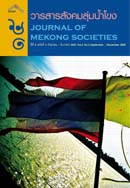The Investigation of the Tie-dye Technique of Bai Minority in Dali
Main Article Content
Abstract
The cultural and historical value of Bai tie-dye occupies an important position in China’s ethic art. With social development, however, Bai tie-dye has been influenced by many factors, including the tourism industry and mass culture. It has already made adjustments and is attempting to adapt to modern life. However, during the process of development, commercialization has caused a decrease in the traditional tie-dye technique and a replacement of traditional natural dye by synthetic dye. Moreover, the original cultural characteristics have been replaced by those of civil society. The present study examines the detailed tie-dye method using field investigations in the important production and market places of Bai tie-dye, the ancient city of Dali, Xi Zhou district, and Zhoucheng village. Through the investigation, the author found problems relating to the future of Bai tie-dye existence. Some are unique, while others are common to other ethic arts. The author recommends that the balance between cultural and economic perspectives should be considered เท order to encourage optimal development of Bai tie-dye. More importantly, Bai people themselves should take tie-dye more seriously as an important symbol of their culture.


